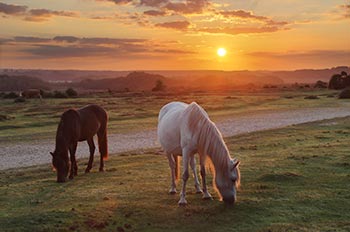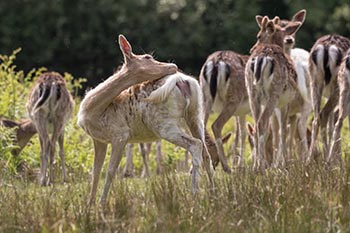Beaulieu
Character, history and location - a 'beautiful place'
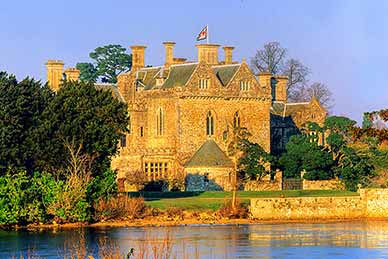
Beaulieu is located on the south-eastern edge of the New Forest, 12 kilometres (7½ miles) from Lyndhurst, and well lives up to Beaulieu Abbey’s original Anglo-Norman, Latinised name Bellus Locus Regis, ‘the beautiful place of the king’.
Beaulieu has, in fact, a strong claim to be amongst the most attractive, most pleasantly situated, most historically interesting of all the New Forest villages.
Beaulieu - first impressions
Visitors entering Beaulieu from an easterly direction – from Hythe and the A326 – pass first on the left, the picturesque Beaulieu River, whilst Beaulieu’s 13th century parish church can be seen on the right, set well back from the road. The Beaulieu Abbey Outer Gatehouse, a structure dating back to the 14th century, is also on the right, beside the road as it bends left to enter the village; and beyond the gatehouse, again on the right, is Palace House, an imposing building that is the home of the Montagu family.
Those coming into Beaulieu village from the opposite direction - from Brockenhurst, Lymington or Lyndhurst – are likely to first notice the large, reed-fringed tidal mill pool - the Mill Dam - that dominates the north-western edge of the village. This was created in medieval times by Beaulieu Abbey monks who built a dam to provide water power to drive their corn mill.
But before travellers from Brockenhurst and Lymington reach the village centre, they may notice just outside the parish boundary, another quite large stretch of water: Hatchet Pond.
Beaulieu Abbey, Palace House and the National Motor Museum
Beaulieu Abbey, Palace House and the National Motor Museum collectively offer the opportunity to walk around what remains of the Cistercian Abbey ruins and learn about the life of the monks; explore the historic stately home and gardens; view the extensive collection of motor cars and motoring memorabilia; and enjoy a variety of rides and drives.
Beaulieu Mill
Now owned by the Beaulieu Estate, the mill is one of a small number of relatively intact tide mills that survive in Britain. It is unlikely, though, that it will ever be returned to full working order.
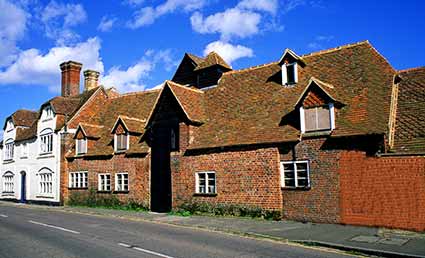
The Mill Dam - a haven for wildlife
Bordered on one side by Palace House and its grounds, on another by cottages and elsewhere by reeds and open shores, the dam forms a picturesque part of the village's impressive landscape and is a haven for wildlife.
Little egrets and grey herons stalk their prey in the shallow waters, oystercatchers and redshanks use their long bills to probe the mud for morsels, and mute swans glide smoothly across the water, accept bread from visitors and build their nests amongst the dense, waterside vegetation.
Other waterfowl are often present, and in spring and summer, swallows hawk for insects above the water's surface. The sharp-eyed might even see a kingfisher flash by or perched on an overhanging branch, resting after a meal or peering down into the water, ready to pounce.
Migratory brown trout pass through on their journey from the sea to spawn in the upper reaches of the Beaulieu River. Some travel by again as adults heading back to sea, whilst youngsters, too, make the journey to spend their early years in salt water.
The village street
Beaulieu’s narrow village street, High Street, is lined on either side by brick-built properties dating mostly from the 17th, 18th and 19th centuries. Shops are relatively few in number – this is a village of modest size – and include a post office and general store, delicatessen, garden centre, hair and nail studio, tea rooms and a picture gallery featuring original works and limited edition prints of local and other subjects.
The Montagu Arms dominates Beaulieu’s main through route. Described as a luxury country house hotel, it provides accommodation as well as featuring a popular restaurant and bar.
Wanderers along the way
Ponies and donkeys graze Beaulieu mill pool’s grassy borders, others wander the High Street, whilst yet more loiter around the village car park, waiting hopefully to be fed by passers-by. Cattle can also often be seen nearby, roaming free, enjoying access to the village and surrounding common lands.
Buckler's Hard
The tiny hamlet of Buckler's Hard is nearby.
Situated amidst delightful scenery alongside the Beaulieu River, Buckler's Hard allows visitors to experience and learn about life in an 18th century ship-building village, cruise on the river and enjoy woodland and riverside walks. The Master Builder’s House Hotel offers a choice of food, drink and accommodation, and there is also a tea room present.
A pleasant 4½ mile (7.5 kilometre) walk route - which is also suitable for cyclists - links Beaulieu with Buckler's Hard.
Hatchet Pond
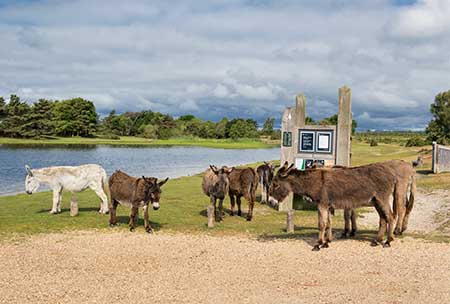
And finally when considering Beaulieu's attractions, Hatchet Pond is not too far away.
Close to the Beaulieu parish boundary but on the East Boldre side, Hatchet Pond is the largest area of fresh water hereabouts. Fed by narrow streams that drain the adjacent heathland, the pond is on the site of a series of marl pits that around 200 years ago were flooded by damming the main stream so as to provide water to power a nearby mill.
It's now an ever-popular picnic spot, a place to sit, relax and simply watch the world go by. New Forest ponies and other animals graze the margins and loiter at the water's edge, wildlife is abundant and for those who enjoy a stroll, the pond makes a good start point for a variety of waterside, heathland and woodland walks and cycle rides.
Fishing permits are available and for history enthusiasts, the site of East Boldre Airfield - one of the UK's first airfields, dating back to before the First World War - is nearby, and so is the site of the Second World War, RAF Beaulieu airfield.
Beaulieu places to stay
Bed and breakfast facilities are available within Beaulieu village and in a number of outlying properties. The nearest (Camping in the Forest) campsites are at Roundhill, 8 kilometres (5 miles) away on the Brockenhurst road; and at Denny Wood and Matley Wood, 9.5 kilometres (6 miles) distant on the road leading from Beaulieu to Lyndhurst.
References:
Hampshire Place Names: Richard Coates
The New Forest: Jack Hargreaves and Terry Heathcote
An Album of Old Beaulieu and Buckler’s Hard: Susan Tomkins
More links
Other related links
Search this site

Sadly, 58 animals were killed - 35 ponies, 13 cows, 8 donkeys and 2 sheep, whilst a further 32 were injured - 3 pigs, 9 donkeys, 11 cows and 9 ponies.
(Forty-three accidents occurred in daylight, 15 at twilight and 101 in the dark. Twenty-seven accidents were not reported by the driver involved).
Here's just one horrific example - Three donkeys killed in collision with van at notorious New Forest blackspot (Advertiser and Times)
